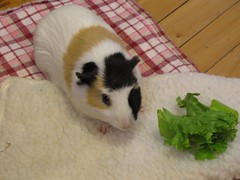
I can't count the number of times I've had this exact conversation:
"How many guinea pigs do you have?" "Two. What about you?"
"Seven." "SEVEN?! How do you do it?!"
In honor of that ever-present question, I'd like to introduce y'all to a new series called How Do You Do It?! [fear not, penny pinchers, I still have plenty of
money-saving tips to share with you.]
Episode 1: Preparing Salads.
With all of the salad-eating critters in this house (currently there are ten!), the sheer idea of preparing a fresh salad every morning and evening is exhausting. I prepare all of my salads for the week in one fell swoop for a number of reasons. First and foremost, it saves a boatload of time. It also allows me to budget better, since I can portion everything out in advance for the week, and I'm never stuck making that late-night run to the supermarket because we ran out of parsley. I always know days in advance just exactly when the food supply will run out. I like to mark this day on the big office desk calendar on the side of our main refrigerator.
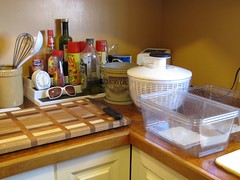
So here, just for you, is a set of step-by-step instructions on how I prepare my salads for the week.
Step 1: Assemble your containers.
To store my salads for the week, I use big plastic containers that once held salad mixes. In Upstate NY, these containers are not recyclable, because they are stackable. But, so long as you are not using them to store a cold liquid or anything hot, they make wonderful storage containers. I use them for everything, from dishwasher detergent to Bunny Chow. One of these big containers holds about 8-10 cups of packed greens. So it is perfect for my 7 guinea pigs. I give them half of a container in the morning, and

half at night. You can also use tupperware containers, ziploc bags or any container you'd like, really.
I keep all of these containers in our spare refrigerator, which also stores our local meat [frozen], big meals, and other non-everyday stuff. Putting a piece of paper towel or a washrag in the bottom of the container helps to keep your salads dry while they are being stored.
Other essentials: A cutting board, a salad spinner [your salads will not keep if they are soaking wet], additional containers, sunglasses.
Optional: a bucket for your scraps--for compost!

Step 2: Cleaning Your Meals-to-be.
Give your veggies/greens a rough chop and throw them in the strainer part of the salad spinner. Spray them with a mixture of 1 part distilled white vinegar and 1 part water. This is especially important if you are not using organic vegetables. Pesticide poisoning is real and it has claimed too many lives. Rinse thoroughly with cold tap water. Shake out as much water as you can. Spin them through the salad spinner and, when they are as dry as can be, set them aside
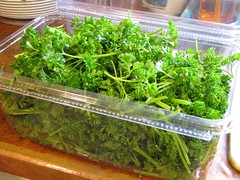
in one of your extra containers.
Repeat this for all of the veggies and greens in your salad.
And don't forget to chop up your worm food nice and small for those tiny mouths!
Step 3: Distribute.
You can do this one of two ways:
If you are planning to use one container per day, you can lasagna-layer your greens.
If you plan to use one container for a few days in a row, you can toss the salad to ensure that everybody gets a bit of everything.
Here I have shown the lasagna-layering in action, as it is the method that I use.
Close up your containers and stash them in the fridge.
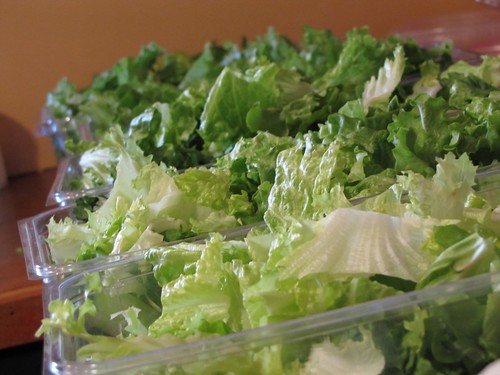
Step 4: Treat yourself.
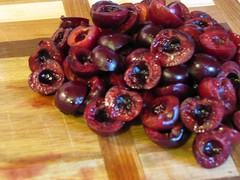
Congratulations! You've just saved yourself some pretty valuable time by preparing all of your salads for the week all at once! Don't forget to mark your calendar, and help yourself to some of these cherries that I bought mostly for the guinea pigs. Mostly.
A word about local and organic.
As a future farmer, I am very passionate about choosing foods that were grown or raised sustainably by farmers I know--locals. More and more people are choosing local and/or organic foods to boost their health; why not for your pets? Your guinea pigs should be getting most of their nutrients from their fresh foods, as these are much easier for their little bodies to absorb. Local and organic foods are richer in antioxidants and their vitamin/mineral contents are higher than those of conventionally-grown veggies.
Keep in mind that even though many small-time family farmers may not be USDA certified, they likely follow a similar--sometimes a much more strict--set of guidelines for their farming practices. Most family farmers know that it's best to work with nature, not in spite of it.
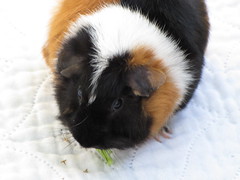 Folks! I would like to apologize for the lack of posts lately. I know this blog is fairly new but my goal was to make at least one post a week. I've unfortunately been backed up with a truckload of work.
Folks! I would like to apologize for the lack of posts lately. I know this blog is fairly new but my goal was to make at least one post a week. I've unfortunately been backed up with a truckload of work. 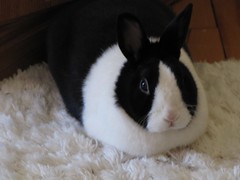




 in one of your extra containers.
in one of your extra containers.

